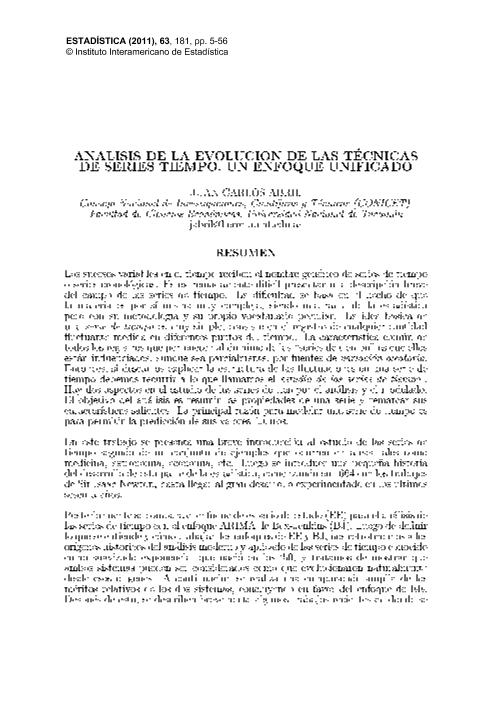Mostrar el registro sencillo del ítem
dc.contributor.author
Abril, Juan Carlos

dc.date.available
2019-03-11T22:01:38Z
dc.date.issued
2011-12
dc.identifier.citation
Abril, Juan Carlos; Análisis de la evolución de las técnicas de series de tiempo: Un enfoque unificado; Instituto Interamericano de Estadística; Estadística (Santiago de Chile); 63; 181; 12-2011; 5-56
dc.identifier.issn
0014-1135
dc.identifier.uri
http://hdl.handle.net/11336/71449
dc.description.abstract
Los sucesos variables en el tiempo reciben el nombre genérico de series de tiempo o series cronológicas. Es extremadamente dificil presentar una descripción breve del campo de las series de tiempo. La dificultad se basa en el hecho de que la materia es por sí misma muy compleja, siendo una rama de la estadística pero con su metodología y su propio vocabulario peculiar. La idea básica de una serie de tiempo es muy simple, consiste en el registro de cualquier cantidad fluctuante medida en diferentes puntos del tiempo. La característica común de todos los registros que pertenecen al dominio de las "series de tiempo" es que ellos están influenciados, aunque sea parcialmente, por fuentes de variación aleatoria. Entonces, si deseamos explicar la estructura de las fluctuaciones en una serie de tiempo debemos recurrir a lo que llamamos el estudio de las series de tiempo. Hay dos aspectos en el estudio de las series de tiempo: el análisis y el modelado. El objetivo del análisis es resumir las propiedades de una serie y remarcar sus características salientes. La principal razón para modelar una serie de tiempo es para permitir la predicción de sus valores futuros.<br />En este trabajo se presenta una breve introducción al estudio de las series de tiempo seguido de un conjunto de ejemplos que ocurren en áreas tales como medicina, astronomía, economía, etc. Luego se introduce una pequeña historia del desarrollo de esta parte de la estística, comenzando en 1664 con los trabajos de Sir Isaac Newton, hasta llegar al gran desarrollo experimentado en los últimos sesenta años.<br />Posteriormente se compara el enfoque de espacio de estado (EE) para el análisis de las series de tiempo con el enfoque ARIMA de Box-Jenkins (BJ). Luego de definir lo que se entiende y cómo trabajan los enfoques de EE y BJ, nos retrotraemos a los orígenes históricos del análisis moderno y aplicado de las series de tiempo conocido como suavizado exponencial que nació en los `50, y tratamos de mostrar que ambos sistemas pueden ser considerados como que evolucionaron naturalmente desde esos orígenes. A continiación se realiza una comparación amplia de los méritos relativos de los dos sistemas, concluyendo en favor del enfoque de EE. Después de esto, se describen brevemente algunos trabajos recientes en donde se aplica el enfoque de EE. Finalmente se realizan algunas consideraciones sobre el uso potencial de los métodos de EE en el trabajo sobre series de tiempo en las estadísticas oficiales y se dan algunas líneas nuevas de desarrollo del área
dc.description.abstract
Time-varying events receive the generic name of time series. It is extremely
difficult to present a brief description of the field of time series. The difficulty lies
in the fact that the subject is in itself complex, being a branch of statistics but
with its methodology and its own peculiar vocabulary. The basic idea of a time
series is very simple, consisting of the registration of any fluctuating quantity
measured at different points in time. The common feature of all records that
belong to the domain of “time series” is that they are influenced, even partially,
by sources of random variation. So if we wish to explain the structure of the
fluctuations in a time series we use what we call the study of time series. There
are two aspects of the study of time series: analysis and modeling. The objective
of the analysis is to summarize the properties of a series and highlight its salient
features. The main reason for a time series model is to allow the prediction of
their future values.
In this paper we present a brief introduction to the study of time series followed
by a set of examples that occur in areas such as medicine, astronomy, economics,
etc. Then we present a short history of the development of this part of statistics,
beginning in 1664 with the works of Sir Isaac Newton, until the great development
experienced over the last sixty years.
Later we compares the state-space approach (SS) for the analysis of time series
with the approach of Box-Jenkins ARIMA (BJ). After defining what is meant
and how they work both SS and BJ approaches, we go back to the historical
origins of modern and applied time series known as exponential smoothing which
was born in the 50s, and try to show that both systems can be considered that
they naturally evolved from those origins. Following that we give a comprehensive
comparison of the relative merits of the two systems, concluding in favor of the SS
approach. After that we briefly describe some recent work where the SS approach
is applied. Finally, some considerations are made on the potential use of SS
methods in the time series work of official statistics and provides some new lines
for the development of the area.
dc.format
application/pdf
dc.language.iso
spa
dc.publisher
Instituto Interamericano de Estadística
dc.rights
info:eu-repo/semantics/openAccess
dc.rights.uri
https://creativecommons.org/licenses/by-nc-sa/2.5/ar/
dc.subject
Arima
dc.subject
Box-Jenkins
dc.subject
Espacio de Estado
dc.subject
Suavizado Exponencial
dc.subject.classification
Economía, Econometría

dc.subject.classification
Economía y Negocios

dc.subject.classification
CIENCIAS SOCIALES

dc.title
Análisis de la evolución de las técnicas de series de tiempo: Un enfoque unificado
dc.title
Analysis on the evolution of the time series analysis: An unified approach
dc.type
info:eu-repo/semantics/article
dc.type
info:ar-repo/semantics/artículo
dc.type
info:eu-repo/semantics/publishedVersion
dc.date.updated
2019-03-08T15:04:29Z
dc.journal.volume
63
dc.journal.number
181
dc.journal.pagination
5-56
dc.journal.pais
Chile

dc.journal.ciudad
Santiago de Chile
dc.description.fil
Fil: Abril, Juan Carlos. Consejo Nacional de Investigaciones Científicas y Técnicas. Centro Científico Tecnológico Conicet - Tucumán; Argentina. Universidad Nacional de Tucumán. Facultad de Ciencias Económicas. Instituto de Investigaciones Estadísticas; Argentina
dc.journal.title
Estadística (Santiago de Chile)

dc.relation.alternativeid
info:eu-repo/semantics/altIdentifier/url/http://www.contraloria.gob.pa/inec/IASI/datos/revista/Vol.63-181.pdf
dc.relation.alternativeid
info:eu-repo/semantics/altIdentifier/url/http://www.contraloria.gob.pa/inec/IASI/publi_journal.html
Archivos asociados
